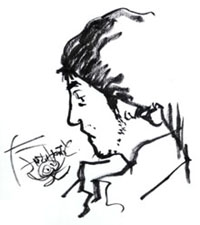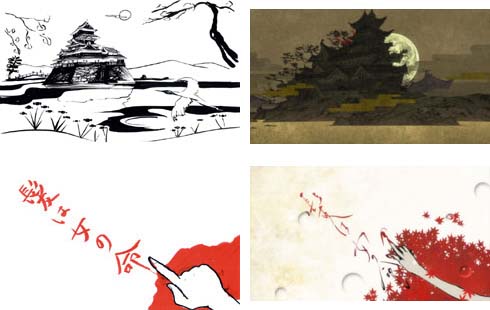The Making of Asience 5 part I: Kazuto Nakazawa (Director)
Kazuto Nakazawa did not just direct Asience: Hairy Tale. He was also responsible for character design, storyboards, animation directing and key art. The final result is a sixty-second concentrate of Nakazawa-esque themes and elements, and the film received great attention from international festivals throughout the globe. Nakazawa has been extensively involved with Production I.G's projects such as the animation segment in Kill Bill: Vol.1, the second opening sequence for the TV series Blood+, and the award-winning Kirin Lemon Black commercial. While focusing on Asience, we took this opportunity and asked Nakazawa the basics of creating anime by going over the works he directed in the past. This is the first of our exclusive 4-part interview with one of the most talented animators in the world scene.
 | Kazuto Nakazawa - Born in Niigata Prefecture on March 4, 1968. Animator. After graduating from the Tokyo Animator Gakuin, he joined studio Magic Bus, and later moved to studio Manglobe. His credits include Kill Bill: Vol. 1 (2003, animation sequence director), TV series Samurai Champloo (2004, character design, chief animation director), Linkin Park's video clip Breaking the Habit (2004 MTV VMA Viewer's Choice Award), the commercial film Kirin Lemon Black: Monster Blacks Fights Back (Best Commercial Film at the 11th Holland Animated Film Festival) and the episode Moondrive in Genius Party Beyond (2008). |
part I
Firstly, what made you decide to take up drawing as a profession?
Do you remember having someone in your elementary school or junior high class who was good at drawing? I was that kid who'd be always drawing for friends. They'd ask me to draw a tiger on a school bag, a shark on a shoe and so on.
A shark on a shoe??
He was a rough kid. (lol) Anyways, when you are good at drawing, you are a hero until you are in the lower grades of elementary school. But as you advance to junior and senior high schools, you become the one who paints billboards for the school sport meets and that kind of stuff. (lol) To tell you the truth, I wasn't particularly interested in drawing. I was just fairly good at it.
Were you interested in films then?
I wasn't really impressed with Japanese films since they overly reflected the directors' egos, but I loved Hollywood films and animations. Same with paintings. I loved manga and anime better than classic academic paintings, because they were more vulgar, rather laid-back, and fun.
What was your favorite anime in those days?
I liked the first Gundam. I recall I went to theatres to watch the Gundam movie trilogy. I was crazy about Yoshikazu Yasuhiko drawings.
Do you think watching those anime back then gave you the idea of becoming an animator?
No, I lived in a really rural, middle-of-nowhere place, so I couldn't even imagine who they were. I joined an animation company, but that was because I was one of those who couldn't think of anything else to pursue. When I found everybody at the studio were high-level people, I was awed. That was a sort of culture shock for me.
But unlike other people from my generation who watched anime on TV, I had not been mesmerized by Yoshinori Kanada's audacious style, so I ended up joining the industry without a real awareness of the influence he was having on so many would-be and professional animators. I realized this when I was a freshman in a studio and candidly asked Atsuko Ishida, "Who's this Kanada guy everybody's talking about?" I still remember her words when she scolded me. "Whaaat? Are you insane?" (lol)
What was your reaction? Did you feel some kind of rivalry?
Never. I have never thought that way in my life.
But now you have become a world-renowned director.
Oh, no. I am an "animator," not a "director." It is true that after Kill Bill: Vol.1, I am getting more assignments as a director, but I wasn't really interested in directing at first. I mean, a director in an animation production is a sort of mid-level manager, and I could not imagine anything more distant from a creative job. It's not exactly the kind of work that fits with my personality. As I'm getting older, I find myself in a position where circumstances are forcing me to do this type of job. Since I can draw, I am also able to "direct," but I don't have the patience to organize a group of individuals together.
What brought you to the Asience project?
Initially, it was Mitsumoto-san (**) from Production I.G who approached me. He said, "Would you be interested? You can do whatever you like on the theme of hair." That was a total lie when I think of it now. (lol) When I met with a representative from the ad agency, they already had a framework for the project.

Doesn't that make things difficult to work on?
It does! And in their image board, you had this father character who was the only one sporting this archaic Jomon-like face with an odd straight forehead hairstyle. And they wanted to close the film with "Hair is the heart of a woman" written in blood. But that's that. With a little clue, I can usually do the rest. I mean I knew this film clip had to start with a castle in the background and end with "Hair is the heart of a woman." So I simply disregarded the rest. They ordered me to make the final scene one of bloodshed, but I found that idea absolutely unaesthetic, so I changed it into a storm of falling red maple leaves, and at the same time I soften the blood spurting about with a spray effect. I also made the storyline flow through the four seasons to give it more of a Japanese feel. After all, this project had fewer binding conditions compared to other commercial films, so the production process was on the easy side. And they liked the final result.
(*) Yoshinori Kanada is considered one of the most revolutionary and influential animators from the 70s, breaking all figurative rules in the highly standardized TV anime production of that era. His hyperdynamicly deformed style and pyrotechnical explosions inspired innumerable would-be animators.
(**) Ryuji Mitsumoto is I.G's chief producer. The Patlabor movies, Ghost in the Shell and Innocence are among his most famous works.
(5/1 - to be continued)
© 1994-2007 KAO CORPORATION. All Rights Reserved.

![WORK LIST[DETAILS]](/contents/works/design/images/left_title.gif)



 terms of use
terms of use